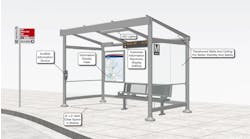STV broke ground on the Massachusetts Bay Transportation Authority’s (MBTA) new Quincy Bus Maintenance Facility.
To celebrate the groundbreaking, STV was joined by U.S. Sen. Elizabeth Warren (D-MA), Massachusetts Gov. Charlie Baker, L.t Gov. Karyn Polito, Massachusetts Department of Transportation Secretary and CEO Jamey Tesler and MBTA General Manager Steve Poftak. STV designed the project in pursuit of LEED and Envision Gold standards to help facilitate the MBTA’s transition to a zero-emission bus fleet.
STV is the lead designer on the $272-million project, which is the first maintenance facility the MBTA will modernize throughout the Greater Boston area and the first in Massachusetts to accommodate both the MBTA’s current fleet of diesel-hybrid vehicles and a future fleet of battery-electric buses (BEB).
“Teamwork was key for our STV Boston office to complete the work on time and within a tight schedule,” said Paul Tyrell, STV vice president and chief civil engineer. “Our staff’s stability and strong lines of communication between disciplines come from years of working on comparable projects and allow us to develop our work cross-departmentally and resolve conflicts efficiently.”
STV executed the design within a constricted 12-month time frame, integrating the latest BEB technology and adapting designs to accommodate MBTA preferences, including significant structural modifications to raise all BEB charges above the ground floor to eliminate any potential impacts during bus movements. The team also complied with the MBTA’s brand-new design guidelines to help decrease their carbon footprint.
“Sustainability and resilience are top priorities in the MBTA’s new procedures,” said Preethi Sreeraj, STV senior civil engineer. “Working within the LEED and Envision frameworks, some essential aspects of our plans include water-efficient fixtures and energy metering through building management systems that let us strategize energy consumption within the facility. Among other sustainable practices, specialized pavement and roof materials with high solar reflection capability were selected to avoid the ‘heat island’ effect that can increase area energy expenditure while decreasing air quality.”



